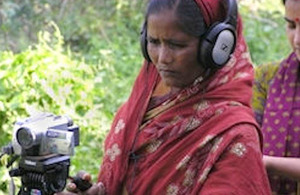DFID Research: how videos can help to improve research participation
Research suggest videos are providing new ways for research participants to articulate their views, and promote debate with stakeholders.

Bangladeshi research participant making a film with the Citizenship DRC
Researchers at the DFID-funded Citizenship DRC are using simple video cameras as innovative research and communication tools to reach new audiences. The videos that are produced are providing a way for research participants to get their message heard, promoting debate with policy makers, community- based groups and NGOs. It has already been shown that participatory video can be a powerful communication tool for people to use to get their ideas and experiences to politicians and the media, groups which they would not be able to reach otherwise.
Training in participatory video for researchers from Brazil, Bangladesh, Mexico, Jamaica, Nigeria, Angola and the UK in 2006 was put in action in 2007 as researchers started to use video as part of their research and to tell people about their activities. They also trained others in their own countries in participatory video, often to great effect:
Joanna Wheeler trained 15 community researchers from favelas or urban slums in Rio de Janeiro while she was researching citizenship in violent areas in Brazil. First using video to conduct conversations around the research questions with community-based researchers, she went on to work with the same community researchers making videos on subjects that were important to them. The community researchers went on to organise a popular public screening and debate around the subject matter which drew in city legislators, the ministry of culture and community leaders, and the next day the screening and debate attracted the attention of the national media.
In Bangladesh, Simeen Mahmud and colleagues are looking at the role of civil society movements in improving democracy, citizenship and participation in society. Working with the Grameen Bank, research participants learned how to use the equipment with little difficulty and conducted interviews, exploring issues including local problems, price rises and current affairs and politics. After carrying out the recordings, community members realized that video could be a powerful way to promote debate and empower the community.
Idaci Ferreira is training other NGOs and community level development workers in Angola to use participatory video in research and other development projects. She describes using video, and especially the way stories can be told and videos edited with the community message in mind as “an amazing experience… It was amazing that people spent a lot of time choosing what they wanted to put in the film… [there was] a lot of debate.” Steve Abah from the Theatre for Development Centre in Nigeria believes the process has been a learning experience for both researcher and research participant: “community members and the organisations you are working with … decide what the story is and who should be recording the stories… it is not us going there and saying this is a new tool and this is how you use it.”
More information
Reflections on Participatory Video as a Research Method with links to YouTube videos
Read the transcript of the introductory YouTube video
See project record Development research centre on citizenship, participation and accountability - Phase 2 on R4D